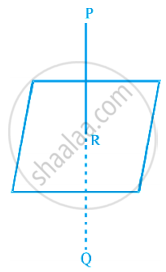Advertisements
Advertisements
प्रश्न
Find the image of the point having position vector `hati + 3hatj + 4hatk` in the plane `hatr * (2hati - hatj + hatk)` + 3 = 0.
उत्तर
Let the given point be P`(hati + 3hatj + 4hatk)` and Q be the image of P in the plane `hatr * (2hati - hatj + hatk)` + 3 = 0 as shown in the figure.

Then PQ is the normal to the plane.
Since PQ passes through P and is normal to the given plane
So the equation of PQ is given by `vecr = (hati + 3hatj + 4hatk) + lambda(2hati - hatj + hatk)`
Since Q lies on the line PQ, the position vector of Q can be expressed as `(hati + 3hatj + 4hatk) + lambda(2hati - hatj + hatk)`
i.e., `(1 + 2lambda)hati + (3 - lambda)hatj + (4 + lambda)hatk`
Since R is the mid point of PQ, the position vector of R is
`([(1 + 2lambda)hati + (3 - lambda)hatj + (4 + lambda)hatk] + [hati + 3hatj + 4hatk])/2`
i.e., `(lambda + 1)hati + (3 - lambda/2)hatj + (4 + lambda/2)hatk`
Again, since R lies on the plane `vecr * (2hati - hatj + hatk)` + 3 = 0
We have `{(lambda + 1)hati + (3 - lambda/2)hatj + (4 + lambda/2)hatk} * (2hati - hatj + hatk) + 3` = 0
⇒ λ = –2
Hence, the position vector of Q is `(hati + 3hatj + 4hatk) - 2(2hati - hatj + hatk)`
i.e. `-3hati + 5hatj + 2hatk`.
APPEARS IN
संबंधित प्रश्न
Three vertices of a parallelogram ABCD are A (3, –1, 2), B (1, 2, –4) and C (–1, 1, 2). Find the coordinates of the fourth vertex.
Name the octants in which the following points lie:
(4, –3, 5)
Name the octants in which the following points lie:
(–7, 2 – 5)
Determine the point on z-axis which is equidistant from the points (1, 5, 7) and (5, 1, –4).
Show that the points A(3, 3, 3), B(0, 6, 3), C(1, 7, 7) and D(4, 4, 7) are the vertices of a square.
Find the locus of P if PA2 + PB2 = 2k2, where A and B are the points (3, 4, 5) and (–1, 3, –7).
Show that the points (a, b, c), (b, c, a) and (c, a, b) are the vertices of an equilateral triangle.
Verify the following:
(0, 7, –10), (1, 6, –6) and (4, 9, –6) are vertices of an isosceles triangle.
Verify the following:
(0, 7, 10), (–1, 6, 6) and (–4, 9, –6) are vertices of a right-angled triangle.
Find the ratio in which the sphere x2 + y2 + z2 = 504 divides the line joining the points (12, –4, 8) and (27, –9, 18).
The coordinates of the mid-points of sides AB, BC and CA of △ABC are D(1, 2, −3), E(3, 0,1) and F(−1, 1, −4) respectively. Write the coordinates of its centroid.
Write the length of the perpendicular drawn from the point P(3, 5, 12) on x-axis.
Find the point on x-axis which is equidistant from the points A (3, 2, 2) and B (5, 5, 4).
The ratio in which the line joining the points (a, b, c) and (–a, –c, –b) is divided by the xy-plane is
Let (3, 4, –1) and (–1, 2, 3) be the end points of a diameter of a sphere. Then, the radius of the sphere is equal to
What is the locus of a point for which y = 0, z = 0?
The coordinates of the foot of the perpendicular from a point P(6,7, 8) on x - axis are
The length of the perpendicular drawn from the point P (3, 4, 5) on y-axis is
The x-coordinate of a point on the line joining the points Q(2, 2, 1) and R(5, 1, –2) is 4. Find its z-coordinate.
If α, β, γ are the angles that a line makes with the positive direction of x, y, z axis, respectively, then the direction cosines of the line are ______.
A line makes equal angles with co-ordinate axis. Direction cosines of this line are ______.
Find the equation of a plane which bisects perpendicularly the line joining the points A(2, 3, 4) and B(4, 5, 8) at right angles.
Show that the points `(hati - hatj + 3hatk)` and `3(hati + hatj + hatk)` are equidistant from the plane `vecr * (5hati + 2hatj - 7hatk) + 9` = 0 and lies on opposite side of it.
The vector equation of the line through the points (3, 4, –7) and (1, –1, 6) is ______.
